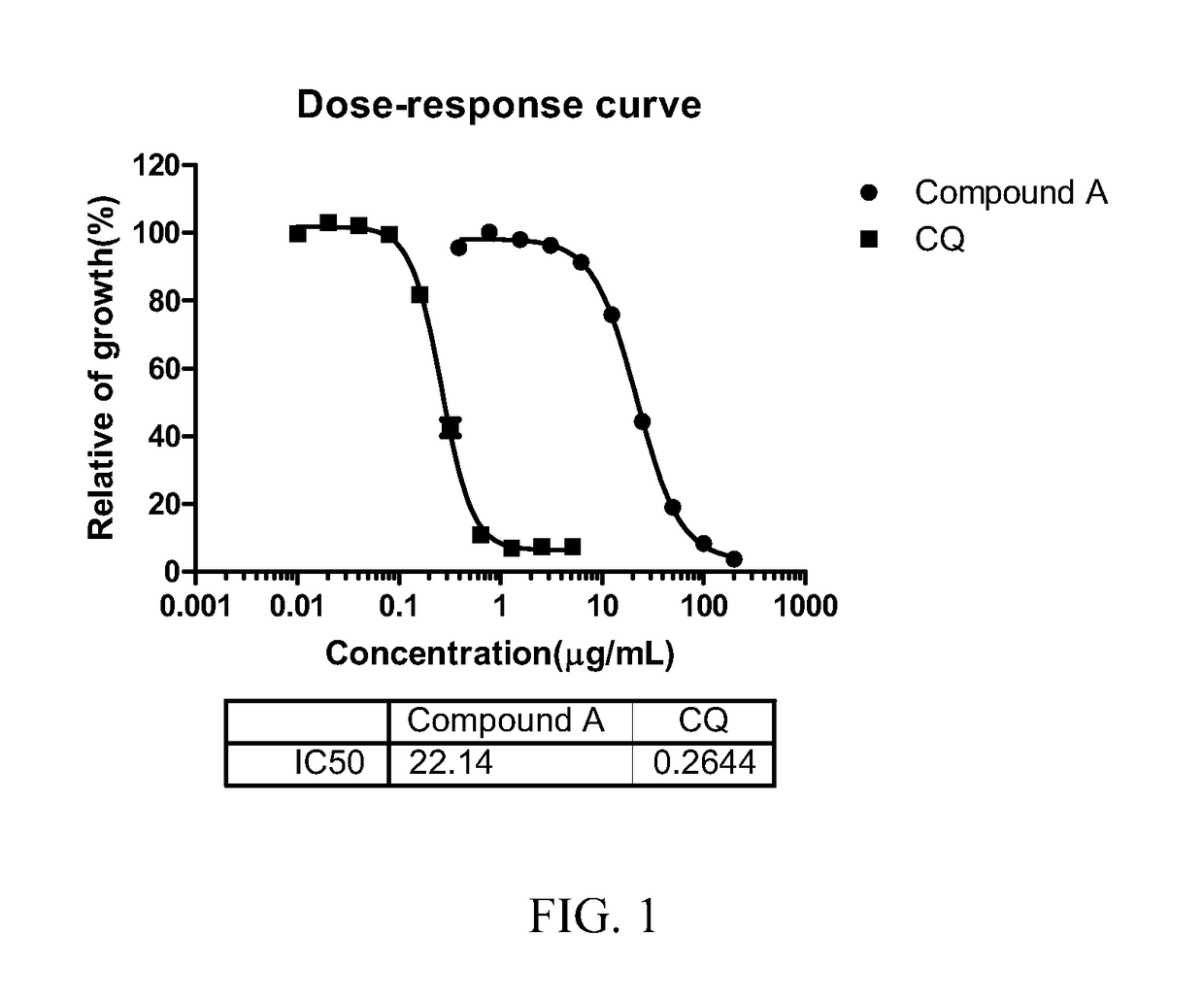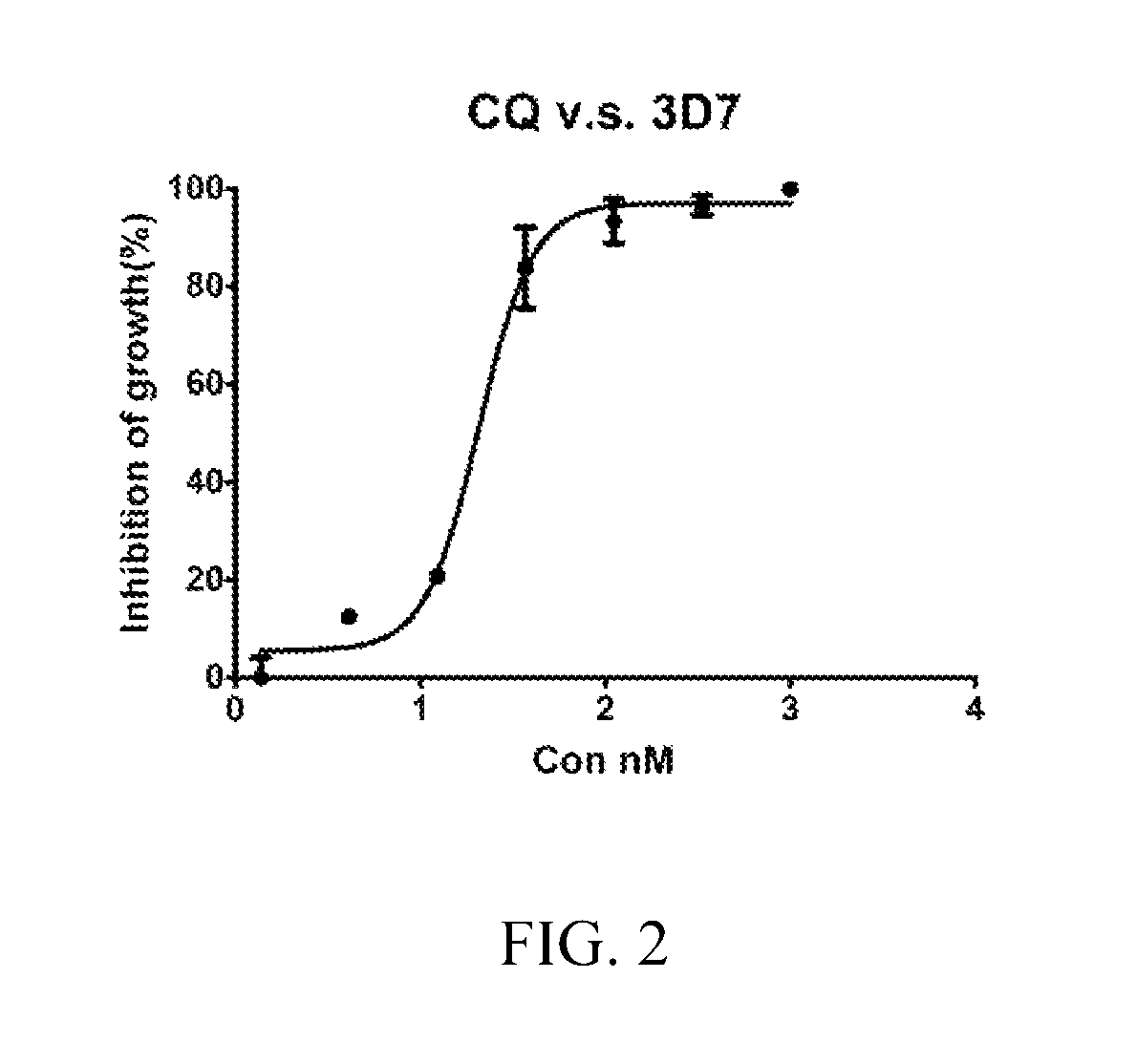Compositions and methods for treating multi-drug resistant malaria
a multi-drug resistant, malaria technology, applied in the direction of drug compositions, antiparasitic agents, plant/algae/fungi/lichens ingredients, etc., can solve the problems of drug resistance and high cost of drugs and medical treatment, and 11% of all children's deaths in developing countries, and achieve the effect of improving the quality of li
- Summary
- Abstract
- Description
- Claims
- Application Information
AI Technical Summary
Benefits of technology
Problems solved by technology
Method used
Image
Examples
example 1a
[0047]Sample No. 1: Rebaudioside A (Stevia leaf pure extract), >95% purity by weight
[0048]Sample No. 2: Steviol Glycosides (Stevia leaf pure extract), ca. 95% purity by weight
[0049]Sample No. 3: Luo Han Guo fruit pure extract powder containing Mogroside V (ca. 40% by weight)
[0050]Sample No. 4: Luo Han Guo juice concentrate (from Fresh Luo Han fruit)
[0051]Sample No. 5: Luo Han Guo extract (water phase)
[0052]Sample No. 6: Luo Han Guo extract (n-butanol phase)=“Compound B”
[0053]Sample No. 7: Luo Han Guo extract (EtoAc phase)=“Compound A”
[0054]Sample No. 8: Luo Han Guo general extract (from Dried Luo Han fruit)
[0055]As a first step, Luo Han fruit powder (135 mg), i.e. pure extract powder containing Mogroside V (ca. 40% by weight), was reconstituted in water by hot water extraction (3×400 mL), and the combined water extracts were partitioned, first with EtOAc (200 mL, 2×100 mL), and next with n-butanol (200 mL, 2×100 mL), respectively, to yield 3 fractions corresponding to Samples 5-7 ab...
example 1b
[0058]The Plasmodium falciparum multidrug resistant strain (MDR) 7G8, (obtained from the Malaria Research and Reference Reagent Resource Centre (MR4), Manassas, Va., USA), was in vitro cultured in RMPI 1640 cell culture medium (supplemented with 10% Human Serum) with PCV (packed cell volume) at 5%. The P. falciparum was cell synchronized by adding 5% of D-sorbitol, and synchronized cells were then spread on culture plates after achieving ring form phase, with an initial infection rate of 1% and PCV at 5%.
[0059]The DMSO stock solutions for Sample No. 7 (“Compound A”) and Sample No. 6 (“Compound B”) as above were diluted by culture medium to 2000 μg / ml as the mother solution and diluted by culture medium for gradient concentration in 3 fold serial dilution form in an activity testing assay (active ingredient solutions should be less than 10% of the culture system, and DMSO concentration should be lower than 0.5% to avoid adverse influence on P. falciparum growth). 10 μl active ingredi...
example 1c
[0063]Parasite cultivation. Drug-sensitive clone 3D7 and multi-drug resistant (MDR) clone Dd2 of Plasmodium falciparum, obtained from the Malaria Research and Reference Reagent Resource Centre (MR4), Manassas, Va., USA, were maintained continuously in blood group O+ human erythrocytes and 10% human serum in a gas mixture consisting of 7% CO2, 5% O2 and 88% N2.
[0064]The stock solutions of Example 1A, and CQ employed as the positive control (prepared as a 10 mM stock solution in PBS), were stored at −20° C. Each working solution was freshly prepared in cell culture medium. In all assays, the concentrations of DMSO and PBS were maintained at 0.5% which did not affect growth of control cultures.
[0065]In vitro inhibitory concentration assays. P. falciparum clones 3D7 and Dd2 were maintained continuously in blood group O+ human erythrocytes and 10% human serum in a gas mixture consisting of 7% CO2, 5% O2, and 88% N2, synchronized by serial treatments with 5% D-sorbitol. In vitro growth in...
PUM
| Property | Measurement | Unit |
|---|---|---|
| concentration | aaaaa | aaaaa |
| total volume | aaaaa | aaaaa |
| emission wavelengths | aaaaa | aaaaa |
Abstract
Description
Claims
Application Information
 Login to View More
Login to View More - R&D Engineer
- R&D Manager
- IP Professional
- Industry Leading Data Capabilities
- Powerful AI technology
- Patent DNA Extraction
Browse by: Latest US Patents, China's latest patents, Technical Efficacy Thesaurus, Application Domain, Technology Topic, Popular Technical Reports.
© 2024 PatSnap. All rights reserved.Legal|Privacy policy|Modern Slavery Act Transparency Statement|Sitemap|About US| Contact US: help@patsnap.com










